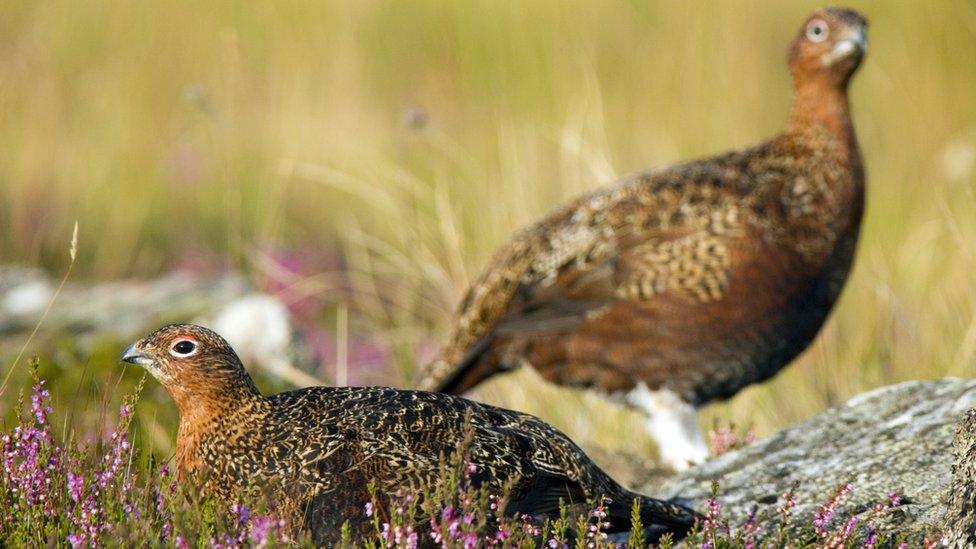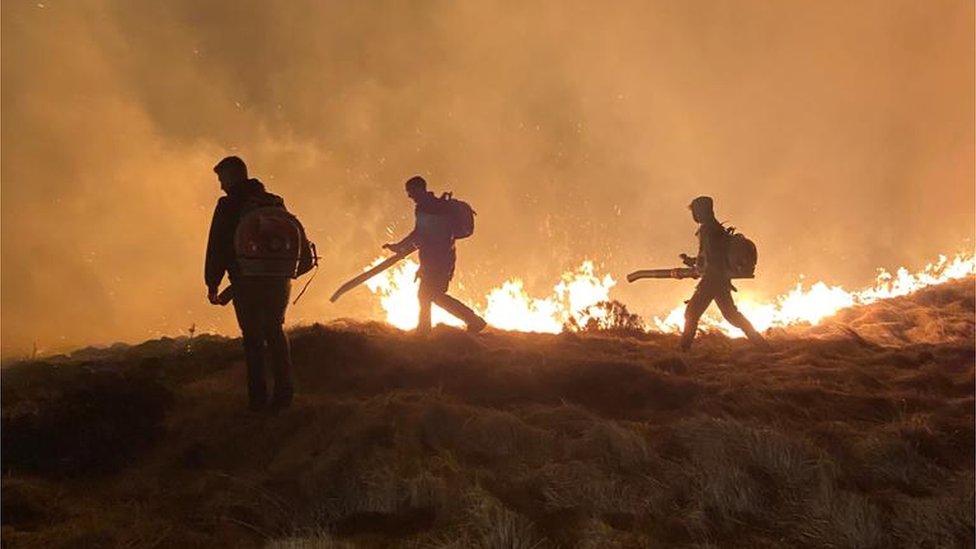Sheffield: plumes of smoke prompt air quality and wildlife concerns
- Published

Controlled burning has prompted concerns about air quality and wildlife
Controlled burning which left Sheffield covered in a blanket of smoke has been criticised by a wildlife trust.
According to the fire service, two controlled burns were carried out near Stanage Edge and Strines Moor in the Peak District on Monday.
The fires have sparked concerns about air quality and the impact on wildlife.
Sheffield and Rotherham Wildlife Trust said these types of fires are used to regenerate heather growth, a practice it has condemned.
Gamekeepers often burn heather on peatland as a way of encouraging new heather shoots for grouse to feed on before they are shot for sport.
However, Sheffield and Rotherham Wildlife Trust cited the degradation to habitat for the likes of hare and upland birds, flood management and the monoculture this creates as major concerns.
The trust's head of land management and conservation, Roy Mosley, said: "It's very disappointing to see these continued fires on our moorlands in Sheffield.
"As well as being internationally important places for wildlife, our uplands provide a huge array of public benefits too."
The trust said volunteers who had been out on site in Wyming Brook, which is located west of Sheffield, struggled with the air quality.
'Huge plumes of smoke'
Resident Ben Barker told BBC Radio Sheffield he had been forced to leave the city due to the amount of smoke.
Mr Barker, from Fulwood, said he and his wife saw "two huge plumes of smoke" looming over Sheffield on their drive back from Derbyshire.
He said: "It was terrible. As we got closer to Fulwood you could really taste the smell, it was horrendous.
"Driving down from the top towards Sheffield you could see that the whole of the Sheffield centre was covered in smoke and that was really worrying, I was very concerned about that."
Mr Barker said he and his wife had both been recovering from a chest infection and left the city again in the afternoon as they had been concerned about their health.
Mr Barker added: "There are clearly thousands and thousands of people whose health will have been compromised by this smoke. It was diabolical."
Derbyshire Fire and Rescue Service confirmed it was aware of two controlled burns near Stanage Edge and near Strines Moor.
Sheffield City Council said while its "non-burning" policy had been in place on the authority's own land since 2016, heather burning remained a legal activity and councils did not have any jurisdiction over it.
Councillor Ben Miskell, chair of the transport, regeneration and climate committee, said: "Our moorland has a special place in the hearts of people in Sheffield and people want to see it protected.
"While the council has limited powers to compel landowners to behave responsibly, we will use all tools at our disposal to encourage them to do so.
"Our biodiversity is precious and needs protecting. That's why landowners should follow our lead and introduce a 'non-burning' policy."
'Reduce risk of wildfires'
Amanda Anderson, director of the Moorland Association, said: "Those conducting conservation and wildfire mitigation burning management on our moors do their best to avoid weather conditions that allow smoke to drift over towns and cities whenever possible. It is regrettable that local residents have had concerns on this occasion.
"By undertaking small controlled burns, a variety of habitats is created, which benefits upland species and reduces the severity of wildfire in the spring and summer.
"Peer-reviewed scientific research shows that curlews are four times as likely to breed successfully on a grouse moor, and other species also benefit from patches of shorter vegetation, along with new shoots that are eaten by grouse, sheep and mountain hare."
Adrian Blackmore, from the Countryside Alliance, which, according to its website, promotes hunting, shooting and angling and the contribution rural communities make to the economy, said grouse moor management played "a key role in creating and maintaining our upland landscape".
"Rotational burning helped "reduce the risk of damaging wildfires and the loss of carbon as a result of these", he added.
"Contrary to the claims made by Sheffield and Rotherham Wildlife Trust, controlled burning benefits not just red grouse, a species that is unique to the United Kingdom, but also many species of threatened ground nesting waders that share this habitat to breed."

Follow BBC Yorkshire on Facebook, external, X (formerly Twitter), external and Instagram, external. Send your story ideas to yorkslincs.news@bbc.co.uk, external.
Related topics
- Published28 June 2018

- Published17 May 2022
